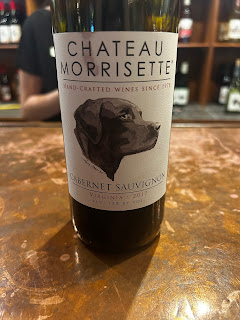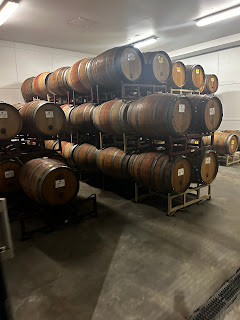Hey Guys! I recently went to Chateau Morisette Winery! This was not only my first time visiting the winery, but also my first time trying ANY wine from Chateau Morisette. It was a clear day when we entered the winery, and we were greeted by one of the Morisette's dogs, Barnabus.
Barnabus on his midday patrol of the winery.
This is the main building for production and tasting. They also have a restaurant across the parking lot, but it was closed when we went.
Once inside the winery, we started with a tasting. Our tasting and tour were done with Amanda, who has been working at the Chateau for a little over a year. I told her about this class and she was happy to give me a run down on all the wines. I tried MANY of their 22 wines available, and got a variety of flavors.
This was their current wine list. We could sample any of the wines they had in stock on the list.
This is the 2020 Chardonnay varietal by Chateau Morisette. Amanda started me with this one because she wanted to build a foundation before our next Chardonnay. This was crisp and lightly flavored, but the flavor lasted a long time even after swallowing.
Amanda followed the 2020 Chardonnay with the 2021 Chardonnay varietal. Both wines were made almost the exact same way. The only difference is that the 2021 went through primary fermentation in oak barrels instead of stainless steel. The wine was fermented in barrels for almost a year. Amanda wanted to show me the difference that fermenting in steel vs. barrels makes. This wine was heavier, with a little hint of vanilla and extremely buttery.
The next wine I tasted was the 2022 Vidal Blanc varietal. This was selected simply because it was Amanda's favorite white wine for any occasion. This was the first vidal blanc I have ever tasted so I did not have much to compare it too. However, it was a perfect wine for a hot day. It was refreshing, light, and fruity with a hint of acidity to balance it out.
Amanda moved us to the reds next, starting with the 2017 Cab Sauvignon varietal. The green tea was a beneficial and surprisingly vibrant flavor that came through in this wine. It was softer and did not have sharp tannins from its aging. It was velvety and a good start to what I expect when trying a cab sav.


The next two we tried to compare. The first is the 2020 Dry Dog which is a red blend containing chambourcin, cabernet, and merlot. This is also the blend used the next wine, The Black Dog. These wines were created and made the exact same, except the Dry Dog was left to ferment until there was NO residual sugar left. The flavor difference between these two wines just from the difference in sugar astounded me. The Dry Dog was tannic and bold and flavorful and made me want to sit down with a nice roasted meat. The Black Dog was sweeter of course, but lighter and something Amanda suggested was amazing used as a cooking wine, or just a casual night out with friends. There was only a 1.2% difference in residual sugars between these two wines, and it surprised me how much that small change altered the flavor.

After introducing some sugar through the Black Dog, we moved on to some sweeter wines. Amanda kicked this off with their OG- Our Dog Blue. This was a semi-sweet white blend that included riesling and traminette grapes. It was light, delicately sweet, and what I would want at a Fourth of July Party Cookout while I ran around with my family.
We finished the tasting off with one of Chateau Morisette's sweetest wines, Sweet Mountain Laurel. This was a varietal blend consisting of exclusively Niagara grapes. It was nostalgic and aromatic. It reminded me of Welch's white sparkling grape juice that my parents used to give me for the New Years Party- just with some alcohol added. It really was like drinking fruit juice and was simply delicious, but definitely pushing the line of too sweet for me.
After our tasting Amanda took us on a small tour of the production center. We were unable to tour the vineyards because most of their vineyards are actually off-site, but can be seen when driving on the parkway!

This is one of many photos I took when I first walked into the production center. An interesting fact that we learned from Amanda is that the Morisette family care deeply about the environment, as they were farmers first before becoming winery owners. With that being said, most of the wood used to build the production center and winery is refurbished and pulled out of rivers and other water logged areas. They had the wood dried, treated, and driven up the mountain. Amanda's favorite beam (as she put it) is one of the center beams in the tasting room (seen in the ceiling in the photo below- the vertical beam on the right going the length of the room). It came from Oregon and traveled all the way to Virginia in one piece, until they got to Floyd. The curve in Floyd were so tight they had to cut the 90 foot beam in 2 places, breaking it into three parts. They covered this up by putting the support columns in those breaks.

This was one row of stainless steel vats used for primary fermentation. Currently, all of their wines are going through primary fermentation in these vats. Each vat holds 6,000 gallons, and they have 30 of them. This means at one time they can have 180,000 gallons fermenting.
I put this in just to show comparison. They are slowly getting rid of the containers that are not ringed or ribbed like the one on the left. The rings on the rest of the containers are actually put of the refrigeration system and helps temperature control each wine to create the best conditions for fermentation.
This is one of the funnels they had pulled inside (they had a large production section outside that was currently covered because Chateau Morisette if fighting a family of pigeons for the patio the equipment is on, and in order to keep it from getting messed up or nested in they keep it covered)
This was the infamous barrel room. Most of their barrel were in this cooler room that is temperature regulated. We learned that they use their barrels 5 times before they trade them out for a new one.
This was a photo my Mother in Law (middle) said we HAD to have. However, It does show something interesting the winery does. On the barrels behind us, there are dogs stamped on the barrels. On the rack to the left of us, you can see the dog print stamp on the top row. These stamps are placed so that the production workers know if the barrel containers a red or white wine.
Dog stamp= White
Paw Print stamp = Red
The last section we went to was what happens when the wine is bottled. This is part of the assembly wine where the bottles get corked.
After the wine is corked, the labels are put on. Here they were actually playing with some old bottles of wine and labeling them differently to see which looked best.
After this the bottles have foil put over the corks on top. The foil is ONLY put on by hand, even to this day. One of the Morisette's, I believe David, actually is a whiz at this and regularly helps the production team place foil wrappers on quickly.
Here is what the wine looks like after it has been packaged! The Morisette's believe in high quality flavor and do not have a lot of storage space, so they have a 30 day box to store policy. Once a bottle goes in a box, it has to be out of the winery within the month and in the store on the shelf.
Overall, this was an awesome trip. The atmosphere was 9/10, The employees were 10/10, My LEAST favorite wine was a 6/10, and the tour was an 8/10. I thoroughly enjoyed the trip and will be going back soon.
 I chose this actually based on Trader Joe's recommendation! This cheese was listed to go with most wines, and it is the Unexpected Cheddar Cheese that had bits of parmesan mixed in.
I chose this actually based on Trader Joe's recommendation! This cheese was listed to go with most wines, and it is the Unexpected Cheddar Cheese that had bits of parmesan mixed in.  This one was more of a leap for me. I had a couple of friends joining me to taste and they were lactose intolerant, so I found a cheese they could enjoy as well. This is Trader Joe's goat's milk gouda style cheese. Trader Joe's said this cheese paired well with red wine and figs.
This one was more of a leap for me. I had a couple of friends joining me to taste and they were lactose intolerant, so I found a cheese they could enjoy as well. This is Trader Joe's goat's milk gouda style cheese. Trader Joe's said this cheese paired well with red wine and figs.  My last choice was Trader Joe's Irish whiskey cheddar. Honestly, I bought this one because they were letting people sample it in store and it was delicious by itself, but I knew it would be interesting to see if it actually paired with any wine.
My last choice was Trader Joe's Irish whiskey cheddar. Honestly, I bought this one because they were letting people sample it in store and it was delicious by itself, but I knew it would be interesting to see if it actually paired with any wine.  Onto the wines we paired with our cheese, we started with the Chateau Morisette 2020 Dry Dog. This was a red blend that had chambourcin, cabernet, and merlot blended together with NO residual sugar.
Onto the wines we paired with our cheese, we started with the Chateau Morisette 2020 Dry Dog. This was a red blend that had chambourcin, cabernet, and merlot blended together with NO residual sugar.  The second wine we tried with the cheese was the Chateau Morisette classic, The Black Dog. I chose this to see how the addition of sugar would change the flavors, as this is the same red blend as the Dry Dog, but they do not ferment all the sugar out of it.
The second wine we tried with the cheese was the Chateau Morisette classic, The Black Dog. I chose this to see how the addition of sugar would change the flavors, as this is the same red blend as the Dry Dog, but they do not ferment all the sugar out of it. 


























